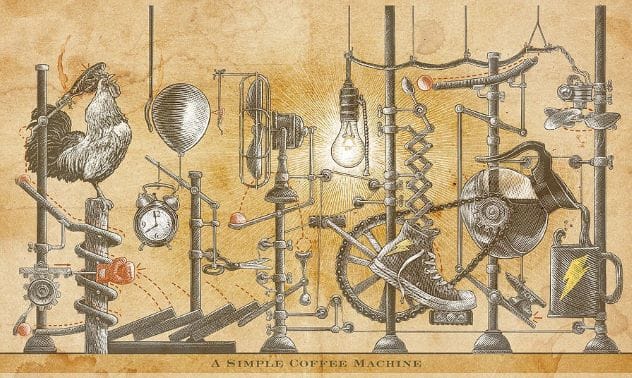Most of us like to get things done in the simplest way. But Rube Goldberg was different! He made people laugh by drawing cartoons of machines that did easy tasks in the most complicated and funny ways. Imagine a self-operating napkin that wipes your mouth using a wild series of events, including a toucan, a rocket, and a falling bucket!
Rube Goldberg lived from 1883 to 1970, but his wacky cartoon inventions have kept inspiring us ever since. Let’s look at 10 surprising places where you might stumble upon a Rube Goldberg-inspired machine.
1. Board Games
Many board games have tried to capture the fun of Rube Goldberg machines. You might have heard of games like Internal Contraption or Factory Fun, where players build their own zany devices.
However, the most famous one is probably the 1963 game, Mouse Trap. In Mouse Trap, players slowly build a kooky machine piece by piece during the game. The grand finale? Using the completed contraption to catch a toy mouse! The machine involves silly steps like a shoe kicking a bucket, a tiny diver, and even a bathtub. The original game box art looked a lot like Rube Goldberg’s cartoons, even using capital letters to mark each step of the machine, just like he did.
This game became so popular that a giant, life-sized version of Mouse Trap once toured the United States. It was a fun way to teach people about basic machines and physics!
2. Computer Games and Apps
It’s no surprise that computer games and apps have also drawn inspiration from these wonderfully complex machines. Sometimes, this happens even when it’s not the main goal of the game! For example, players in Minecraft have built enormous Goldberg machines that trigger a huge number of actions, like changing the landscape before dramatically blowing up a tower.
Other games are specifically designed for building Rube Goldberg machines. Games like ‘The Incredible Machine’ on computers, or the official ‘Rube Works Game,’ challenge you to build your own machine to solve a puzzle. If you search for “Rube Goldberg” in the Google Play or App Store, you’ll find tons of games to try, from educational ones to those that are just pure fun. Many other popular games, like Pull the Pin, Cut the Rope, and Fruit Ninja, also seem to have a touch of Rube Goldberg’s influence in their gameplay.
3. Fine Art

Rube Goldberg himself was a prolific artist, creating over 50,000 cartoons that featured his signature crazy machines. Inspired by his legacy, other artists have embraced the challenge and incorporated Goldberg-type machines into their own artwork.
In some pieces, the artwork clearly shows a machine that would make Rube Goldberg proud. Clint Hansen’s “A Simple Coffee Machine” is a great example. Other artworks are more abstract or surreal, featuring elements that echo Goldberg’s style, like Vanessa Bates’s “Klockwerk Orange Patent Pending” or Mike Savad’s “Steampunk—Coffee Break.”
More recently, some artistic creations don’t even depict a working machine. Instead, they use the machine-like imagery to express emotions like frustration or chaos about a particular topic. Peter Kuper’s “Election Recap” does this. At first glance, it looks like a classic Rube Goldberg cartoon. But if you look closely, you’ll notice missing steps and jumbled letters, cleverly conveying feelings about an election.
4. YouTube
YouTube has become the perfect stage for people to share their amazing homemade Rube Goldberg machines. Creators have built popular machines for all sorts of everyday tasks, like turning the pages of a book, watering plants, and even lighting up Christmas trees in an incredibly roundabout way.
One of the most famous Rube Goldberg machines on YouTube was created by the band OK Go for their music video “This Too Shall Pass.” This incredible machine started with a toy truck knocking over dominoes and included various devices that triggered music and singing along its long, winding path. Some of the most interesting parts included spoons playing water-filled glasses, a falling piano, a typewriter, a smashed television, and a grand finale where paintball guns fired at the singers. Talk about a performance you won’t forget!
Like many true Rube Goldberg machines, this one could only be set off once—at least, not without carefully rebuilding parts of it for another go.
5. Education
It might not surprise you to learn that Rube Goldberg was an engineer by training. Because his machines showcase interesting principles of engineering and physics in such an engaging way, they are often used in education. An organization founded in Goldberg’s name even offers lesson plans and hosts contests, and many schools assign students the fun project of creating their own Rube Goldberg machines.
Beyond teaching science concepts, schools have used Rube Goldberg projects to teach valuable skills like project management and leadership. Building these machines is said to boost creativity and problem-solving abilities. Some students have humorously claimed they mostly learned a lot about what you can do “with random junk.” Regardless of the specific lesson learned, no one can deny that the process of building one is incredibly fun and rewarding.
6. Toys
Any toy that uses a chain reaction can be seen as having a Rube Goldberg style. Think about marble runs, toy roller coasters, LEGO contraptions, and even long lines of falling dominoes. All of these start a chain reaction—the key feature of Goldberg’s inventions—from one little push, drop, or other simple action. Many different construction sets can be used to make crazy contraptions, even if that wasn’t what they were originally designed for.
But here’s the best part: you don’t need a special kit to make a Rube Goldberg contraption. Just gather up anything you have around the house that moves or can be made to move. You can include objects of various weights, string and rope, duct tape, broken pieces of old toys, kitchen utensils, balloons, and anything else lying around that seems like it has no use. A good search through the garage, the toy box, and the attic will surely uncover all sorts of potential machine parts.
What could you set off with a running hairdryer? How could you use that to turn something on? How can you get a toy car rolling down a makeshift track? If you can think of it, it’s fair game!
7. Private Homes
Schools aren’t the only places where these fantastic contraptions are being built. Many families enjoy making them right in their own homes. In fact, during the COVID-19 quarantines in 2020, homemade Rube Goldberg machines became especially popular on YouTube. Some people took a humorous approach to social distancing by creating machines to perform simple tasks, like passing the salt across the dinner table without anyone having to get too close. One family even built a complex machine that snaked throughout their entire house and ended with a foosball goal! I bet making that was much more fun than cleaning it up afterward.
Building Rube Goldberg machines is a fantastic way to keep children entertained, especially when they’re not in school. Just get them started with a simple idea, like launching a teddy bear off a dresser by knocking over a stack of books with a nerf gun dart, and watch their creativity take over!
Of course, they don’t have to turn your house upside down with their contraptions; they can also just draw them, like Rube Goldberg himself did. Some kids (and kids-at-heart) might enjoy this even more because they can include elements they couldn’t practically create in real life—like a canary that sings when something pulls its tail feathers, or a monster truck that triggers an avalanche, chasing a giant snow-spider into a booby-trapped cave. The possibilities are endless!
8. Sports
One of the most common and satisfying end results for a Rube Goldberg machine is making a basketball or another type of ball go through a hoop after a complex chain reaction of silly and ingenious events. Even the world-famous Harlem Globetrotters have joined in on the contraption craze, creating their own impressive Rube Goldberg-style basketball shot machine.
Red Bull, known for its energetic branding, created a memorable ad featuring its own sports-themed machine. This contraption starred various famous athletes, from skydivers and skateboarders to racecar drivers. Each athlete’s stunt would trigger the next stage of the machine, which in turn released the necessary sports equipment for the following athlete. It was a fantastic blend of human skill and mechanical ingenuity, all working together in a perfectly balanced, over-the-top sequence.
9. Music
A few creative musicians have even invented Rube Goldberg machines that play music! Imagine a machine, for example, that uses dropping marbles to create musical notes. Another fascinating invention features various spinning parts and strings that drop balls precisely onto piano keys to play a tune. These musical machines are a delight to watch and hear.
One of the most fun and complex Rube Goldberg music machines impressively incorporates a wide variety of percussion instruments. Drums, cymbals, chimes, and xylophones all come together to create a beautiful, rhythmic melody as balls fly through the intricate machine. Sometimes, a little help from a computer ensures everything works in perfect harmony, but the mechanical magic is still the star of the show.
10. Movies
Movies are a natural home for Rube Goldberg machines because these visual spectacles are best enjoyed as you watch the chain reaction unfold step by step. From the clever traps in Home Alone and the imaginative sequences in Toy Story to the adventurous contraptions in The Goonies and the whimsical machinery in Edward Scissorhands, wacky machines inspired by Rube Goldberg are all over the big screen.
Some of the most memorable movie machines are breakfast-making contraptions. These have appeared in classic films like Chitty Chitty Bang Bang, Back to the Future, and Pee-wee’s Big Adventure. It’s the perfect, nerdy-but-entertaining way for an eccentric character to prepare their morning meal, showcasing their inventive (and slightly bonkers) personality.
A slightly less obvious, but equally Rube Goldberg-esque, machine appears near the beginning of Raiders of the Lost Ark. When Indiana Jones removes an idol from its pedestal, he triggers a massive, deadly contraption in the cave. Why didn’t removing the idol just cause a quick, simple trap? Well, because a complicated Rube Goldberg machine is much more entertaining (and it gives our hero a chance to escape!).
Keep your eyes peeled, and you’ll start seeing these humorous, over-engineered machines everywhere!
Conclusion
Rube Goldberg’s legacy of wonderfully complicated machines continues to charm and inspire us in so many corners of our world. From the toys we played with as kids to the movies we watch and even the art we admire, these intricate contraptions remind us of the joy of creativity and the fun in making simple tasks extraordinarily complex. They show up in education, sports, and countless homemade projects, proving that a little bit of imaginative engineering can go a long way in bringing smiles and sparking curiosity. So, the next time you see a series of unlikely events leading to a simple outcome, you’ll know you’ve spotted a bit of Rube Goldberg magic!
What’s the most amazing Rube Goldberg machine you’ve ever seen? Leave your comment below!










